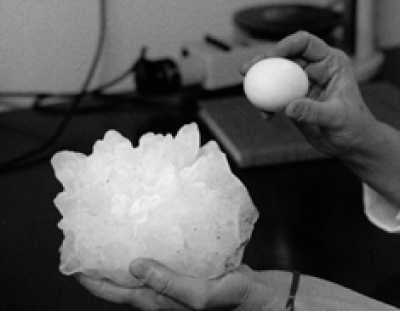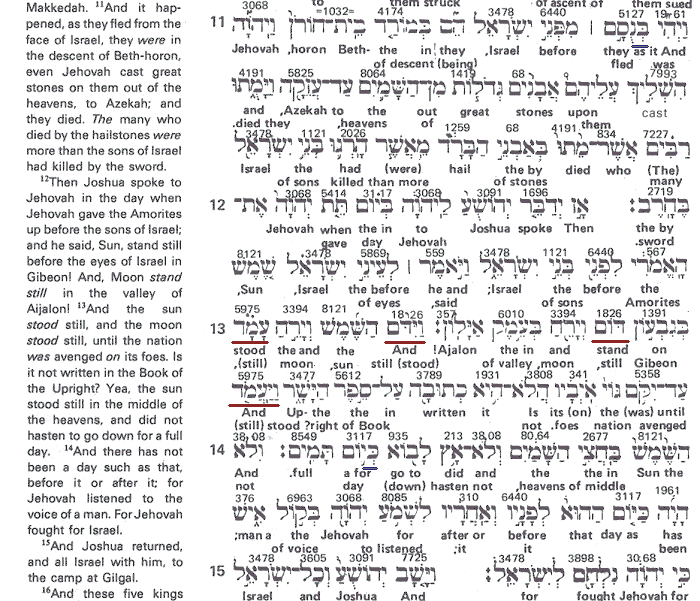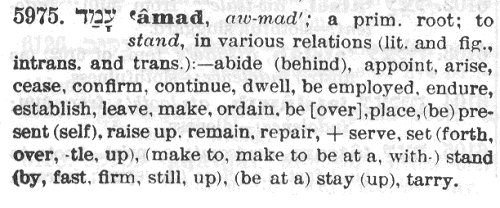For millenniums there has been discussion and controversy over the Scriptural record
of Joshua 10:11-14 . Flavius Josephus in his "Antiquities of the Jews" writes:
and marching day and night, in the morning fell
upon the enemies as they were going up to the seige;
and when he had discomfited them, he followed them,
and pursued them down the descent of the hills.
The place is called Beth-Horon; where he also understood
that God assisted him, which he declared by thunder and
thunderbolts, as also by the falling of hail larger than usual.
Moreover, it happened that the day was lengthened that the night
not come on too soon, and be an obstruction to the zeal of the
Hebrews in pursuing their enemies; insomuch that Joshua took
the kings, who were hidden in a certain cave at Makkedah, and
put them to death. Now, that the day was lengthened at this
time, and was longer than ordinary, is expressed in the books
laid up in the temple." (from the William Whiston translation)
The Hebrew of the text is rather interesting and a close to literal translation might be as follows.
Sun, on Gibeon be dumb (or silent),
and moon, in the valley of Aijalon.
And was dumb (or silent) the sun,
and the moon stood,
until the nation was avenged on its foes.
Is it not written in the Book of the Upright?
And stood the sun in the midst of the heavens,
and did not press to go as on a full day.
And never has been a day that before it or after it;
For Jehovah listened to the voice of a man.
For Jehovah fought for Israel."
Is the translation using the word "still" warranted when earlier in the Scriptures, Exodus 9:16, it is translated as "raised"?
And also as indicated in the Appendix the last phrase of verse 13 could be properly translated "as a day full"
A paraphrase from the Bible in Basic English is;
into the hands of the children of Israel
that Joshua said to the Lord, before the eyes of Israel,
Sun, be at rest over Gibeon;
and you, O moon, in the valley of Aijalon.
10:13 And the sun was at rest and the moon kept its place
till the nation had given punishment to their attackers.
(Is it not recorded in the book of Jashar?)
So the sun kept its place in the middle of the heavens,
and was waiting, and did not go down, for the space of a day.
10:14 And there was no day like that, before it or after it,
when the Lord gave ear to the voice of a man;
for the Lord was fighting for Israel."
Under what conditions could one imagine that there could be the longest and brightest possible lighting condition to provide a figurative resting of the sun and moon upon the area for a figurative space of a day? Short of having the rotation of the earth stop when it seems apparent that to do so would be so catastrophic that no life on the earth would survive. Let us take a look at the possible condition that could accompany a severe hailstorm. We might be tempted to say a "Texas" size hailstorm, but one of the most severe recorded hailstorms of recent history occurred in Kansas.
Hail falls along paths scientists call hail swaths. These vary from a few square acres to large belts 16 kilometers (10 miles) wide and 160 kilometers (100 miles) long. (The hail storm of Joshua 10 went between Beth-horon to Azekah, approximately 15 miles.) Swaths can leave hail piled so deep it has to be removed with a snow plow. In Orient, Iowa, in August 1980, hail drifts were reported to be 2 meters (6 feet) deep. On 11 July 1990, softball-sized hail in Denver, Colorado, caused $625 million in property damage, mostly to automobiles and roofs. Forty-seven people at an amusement park were seriously injured when a power failure trapped them on a Ferris wheel and they were battered by softball-sized hail. A quick search of the internet reveals that there were recorded deaths due to hail stones in the USA on May 8, 1784 at Winnsborough, SC, eight persons were killed. Various other North American reports of deaths from hail came from Broome, Quebec, in 1879; Uvalde, Texas, in 1909; Windsor, North Carolina, in 1931; and near Toronto, Ontario, In 1976. Only two deaths have been authenticated by the National Weather Service (formerly the U.S. Weather Bureau). The first occurred on May 13, 1939, near Lubbock, Texas. A 39-year-old farmer died of injuries received when he was caught in an open field during a severe hailstorm. More recently, an infant lying in its mother's arms was killed by hail at Fort Collins, Colorado, on July 30,1979.
One of the larger hailstones ever documented weighed 0.75 kilograms (1.67 pounds), and spans 14.4 centimeters (5.67 inches), this famous 3rd September 1970 Coffeyville hailstone as shown below is compared to an egg.

And stones weighing between 4 and 5 pounds have been reported. One of the deadliest modern history hailstorms ever recorded was in northern India in 1888, when hailstones the ‘size of a cricket ball’ reportedly killed 246 people and also 1,600 sheep and goats. Some of the victims were hit directly, others perished in drifts several metres deep, and some died from exposure. In 1932 in the western Hunan Province, China, 200 people were killed and thousands injured. (The record of Joshua 10 does not actually tell us how many were killed by the hail.) It is not unusual for a severe hailstorm to rapidly pass over an area in the afternoon and to be followed by beautiful clear skies long before sundown. And often the storm will have washed the atmosphere of most of the particulate matter resulting in one of those nights when the sky is so clear that it appears one can reach up and touch the stars. In the event that sunset would be accompanied by the rise of the moon at or near its brightest possible condition ( the full moon at perigee ) the result would seem to be the most optimum light conditions for the longest hours of a day possible. A long day?
The Israelite army traveled all night from Gilgal to arrive outside of Gibeon for a early
morning surprise for its foes, an ascent of around 4,000 feet and a distance of
more than 20 miles, so they were accustomed to travel at night.
(Archaeologists have not located the exact site of the Gilgal camp between Jerico and the Jordan river.)
After routing the opposing army with a great slaughter outside of Gibeon, they then continued
in hot pursuit toward Beth-horon, where the hailstorm started its destruction.
They pursued the Canaanite coalition down
through the descent of Beth-horon, and then southward across the Valley of Aijalon and
finished the job at Azekah/Makkedah, two neighboring villages approx 20 miles from Gibeon.

This direction of the flow of the battle explains why Joshua was requesting "Sun, be at rest over Gibeon; and you, O moon, in the Valley of Aijalon." The Aijalon Valley was an important military and caravan route through the approximately 1500 feet high rocky plateau called the Shephelah, a major connection route between the Bethel/Gibeon/Jerusalem area and the coastal plain. It was quite an endurance feat for Joshua and his army, hike a three quarters marathon distance overnight, win a decisive battle in the morning, begin the pursuit and witness the partial destruction of the surviving foes by a world class hailstorm and then continue the pursuit for another three quarters marathon distance to complete the destruction of the foes.
Conclusion; Therefore it is proposed that the wording of the Hebrew text does not require the sun to stop in the sky, which would seem to be a breaking of the promise of Genesis 8:22, "While the earth remaineth, seedtime and harvest, and cold and heat, and summer and winter, and day and night shall not cease". The statement "And there was no day like that, before it or after it" would be fully satisfied by a severe greater than "Texas" sized hailstorm followed by a bright clear full moon lit night, allowing the Israelites to pass through the Aijalon Valley and complete the defeat of the foes under a bright clear moonlight sky as Joshua requested of the Lord. Instead of breaking "My covenant with the day and My covenant with the night, so that day and night will not come at their appointed time" (Jeremiah 33:20 RSV), a more practical solution was provided.
Appendix A: Interlinear Hebrew Text for Joshua 10:11-14
Following is an extract from "The Interlinear Bible" (1986) by J. P. Green, Sr. , page 196, with added red underlines to highlight the Hebrew words often translated as "stand still" or "stood still". Note that twice the word "still" is put in parentheses to properly indicated that it is an added word. Another time "stood" is in parentheses and not "still", and the remaining time neither is so designated, rather confusing interpretations.
Also added are two blue underlines showing that in the first line the Hebrew translated as "as they fled" uses the same prefix as that at the ending of verse 13. Therefore, the end of verse thirteen could just as properly be translated as "as a day full" instead of "for a day full".
Also included are extracts from Strong's Hebrew and Chaldee Dictionary for "damam" (#1826), "amad" (#5975) and "tamiym" (#8549).




"lit." and "fig." are abbreviations for "literal" and "figurative" respectively.

